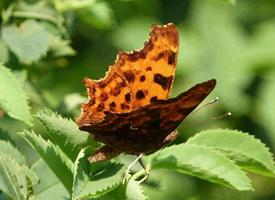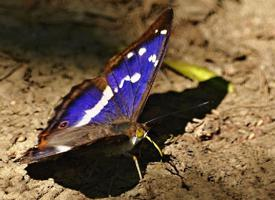
Poids et mesures
| Envergure des ailes | 5 cm |
|---|
Description de l'animal
The Comma (Polygonia c-album) is a fascinating and distinctive butterfly that belongs to the Nymphalidae family, which encompasses a wide range of colorful and diverse butterflies. Named for the small, white, comma-shaped mark on its underwings, this butterfly is an intriguing subject for both amateur naturalists and professional entomologists. Its appearance, lifecycle, and behaviors make it a unique specimen within the butterfly world.Appearance
Adult Comma butterflies are immediately recognizable by their ragged wing edges, which give them a tattered appearance. This unique adaptation serves as excellent camouflage when the butterfly is at rest on tree bark or fallen leaves, blending seamlessly into its surroundings. The upper side of the wings boasts a range of colors from deep orange to brown, with dark spots and a distinctive pattern that varies between individuals. In contrast, the underwing is a cryptic brown and grey, helping it to hide from predators. The small, white 'comma' mark from which it derives its name is located on the underside of the hindwing, providing an easy identification marker.
Lifecycle and Reproduction
The lifecycle of the Comma butterfly is a captivating journey, beginning with the laying of eggs on suitable host plants, which include nettles (Urtica dioica) and hops (Humulus lupulus). After hatching, the caterpillars are spiky and dark with white markings, which serve as a deterrent to predators. They are solitary feeders and undergo several molts before pupating. The chrysalis mimics the appearance of a dried leaf, enhancing its camouflage and providing protection during this vulnerable stage.
Comma butterflies exhibit a fascinating reproductive strategy known as seasonal polyphenism, where individuals born in different seasons exhibit different color patterns and behaviors. This adaptation allows them to maximize their survival and reproductive success throughout the year.
Habitat and Distribution
Originally found in Europe and temperate Asia, the range of the Comma has expanded over the years. It favors a variety of habitats, including woodland edges, hedgerows, gardens, and open fields. The butterfly prefers environments where its host plants are abundant, and it can find suitable spots for basking in the sun. Over the past few decades, there has been a notable increase in the range and number of Comma butterflies, attributed to climate change and changes in agricultural practices that have created more favorable conditions for its survival and reproduction.
Behavior
Comma butterflies are known for their territorial behavior, especially among males during the breeding season. They often perch on prominent leaves or branches, ready to chase away intruders or pursue potential mates. Their flight is fast and erratic, making them a challenging subject for photographers.
Conservation Status
Currently, the Comma butterfly is not considered to be at risk. Its population has been increasing in many areas, partly due to its adaptability to a range of habitats and the increasing prevalence of its host plants in suburban and agricultural landscapes. However, like many species, it could be affected by extreme changes in climate and habitat destruction, making continued monitoring essential.
In conclusion, the Comma butterfly, with its distinctive appearance, fascinating lifecycle, and adaptability, is a remarkable testament to the resilience and complexity of nature. Its presence adds beauty and intrigue to the environments it inhabits, reminding us of the intricate connections within ecosystems and the importance of conserving our natural world.
Animaux similaires
Nouvelles photos d'animaux
Top 10 des animaux
- Dolphin gull (Leucophaeus scoresbii)
- Diana monkey (Cercopithecus diana)
- Moustached guenon (Cercopithecus cephus)
- Galápagos tortoise (Geochelone nigra complex)
- Russian tortoise (Testudo horsfieldii)
- Stone loach (Barbatula barbatula)
- Japanese macaque (Macaca fuscata)
- Greek tortoise (Testudo graeca)
- Common flying dragon (Draco volans)
- Vendace (Coregonus albula)


